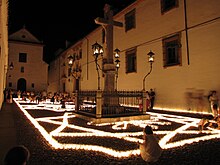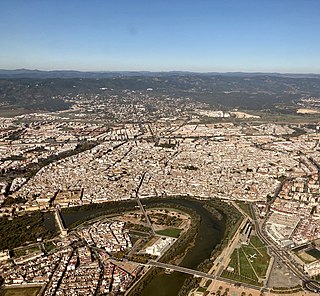
Córdoba, or sometimes Cordova, is a city in Andalusia, Spain, and the capital of the province of Córdoba. It is the third most populated municipality in Andalusia and the 11th overall in the country.
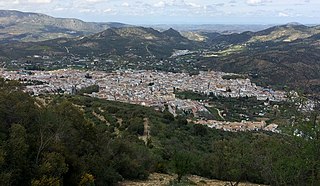
Priego de Córdoba is a town and municipality of Spain located in the autonomous community of Andalusia. It lies on the southeasternmost end of the province of Córdoba, near the headwater of the Guadajoz, and on the northern slope of the Sierra de Priego. The population in 2015 was 22,936.

The Cathedral of Saint Mary of the See, better known as Seville Cathedral, is a Roman Catholic cathedral in Seville, Andalusia, Spain. It was registered in 1987 by UNESCO as a World Heritage Site, along with the adjoining Alcázar palace complex and the General Archive of the Indies. It is one of the largest churches in the world as well as the largest Gothic church.

Montilla is a town and municipality of Spain, located in the autonomous community of Andalusia. As of 2017, the town had a population of 23,209, which makes it the fourth most populated municipality of the Province of Córdoba. It lies 32 miles south of the provincial capital, Córdoba.

Iznájar is a town and municipal area in the province of Córdoba in Andalucia, southern Spain.
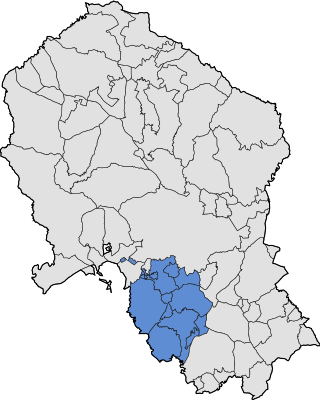
The Campiña Sur, officially the Mancomunidad de la Campiña Sur Cordobesa, is a Spanish comarca of the province of Córdoba, in the autonomous community of Andalusia. It is formed by 11 municipalities and is between the Subbética Mountains and the Guadalquivir Valley, in the south-west of the province. Its capital is the city of Puente Genil, which is also the third largest city in the province, after Córdoba and Lucena.
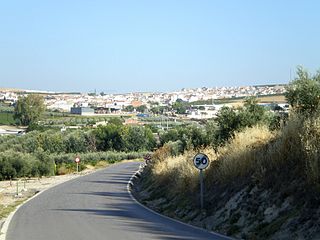
Moriles is a town in the province of Córdoba. In 2018 it had a population of 3,726. The municipality covers an area of about 20 km2 and has a population density of about 194 inhabitants/km2. The town is located about 65 km south of the provincial capital, Córdoba, at an altitude of 375 m above sea level, at co-ordinates 37°26′0″N4°37′0″W.

Macarena is one of the eleven districts into which the city of Seville, capital of the autonomous community of Andalucía, Spain, is divided for administrative purposes. It is located in the north of the city, bordered to the south by the Casco Antiguo and San Pablo-Santa Justa suburbs, to the east and north by Norte and to the west by Triana. It covers the area between the Guadalquivir River and the Carmona Highway and from the SE-30 ring-road in the north to the Ronda del Casco Antiguo. It contains smaller neighbourhoods such as León XIII, Miraflores, and the Polígono Norte as well as the Miraflores park along the SE-30. The district contains the Andalucian Parliament, the Torre de los Perdigones in the park of the same name, and the Hospital Universitario Virgen Macarena

Pedro Abad is a small town located in the province of Córdoba, Spain. According to the 2006 census (INE), the city has a population of 2934 inhabitants.

San Sebastián de los Ballesteros is a city located in the province of Córdoba, Spain. According to the 2006 census (INE), the city has a population of 836 inhabitants.

Alto Guadalquivir is a Spanish comarca in the province of Córdoba. It covers an area of 1,299 km², and has a population of 44,828 inhabitants. It borders the comarca of Valle de los Pedroches to the North; Campiña Este - Guadajoz to the South; Córdoba and the comarca of Valle del Guadiato to the West; and the province of Jaén to the East.

Santa Marina is a church in Córdoba, Spain. It is one of the so-called "Fernandinean Churches," built in Córdoba after Ferdinand III of Castile conquered the city in 1236 CE. The structure combines proto-Gothic, Mudéjar and, to a lesser degree, late-Romanesque elements.

The Cathedral of Córdoba is the colonial cathedral church of the Roman Catholic Archdiocese of Córdoba, Argentina, and the oldest church in continuous service in Argentina.
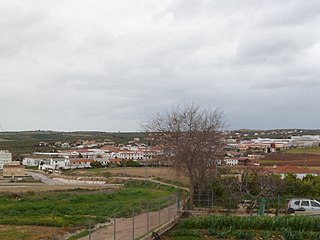
La Rambla is a municipality in the province of Córdoba, Spain.
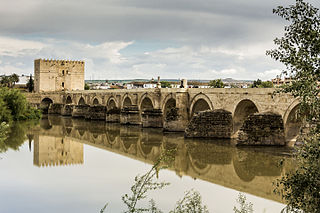
The Roman bridge of Córdoba is a bridge in the Historic centre of Córdoba, Andalusia, southern Spain, originally built in the early 1st century BC across the Guadalquivir river, though it has been reconstructed at various times since. It is also known locally as the Old Bridge as for two thousand years, until the construction of the San Rafael Bridge in the mid-twentieth century, it was the city's only bridge across the river.
The Christ of the Lanterns is a 1958 Spanish film.

The University of Córdoba, is a university in Córdoba, in Andalusia, Spain, chartered in 1972. It offers undergraduate and postgraduate studies in humanities, social sciences, health sciences, natural sciences and engineering.
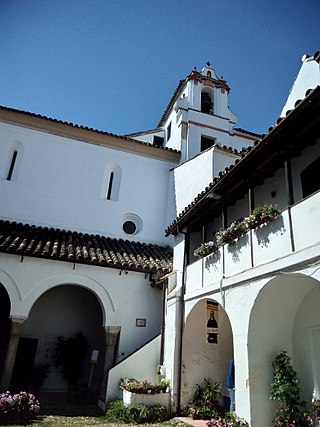
Convento de Santa Cruz is a convent situated in the historic centre, barrio de San Pedro, Córdoba, Andalusia, Spain. It was founded in 1435, by Pedro de los Ríos y Gutiérrez de Aguayo and his wife, Teresa Zurita. The building has always been closely linked to the Ríos family, which were adding new spaces to the original project, resulting in an interesting building composed of different structures organized around courtyards. It is notable for its originality, its architecture, and the artistic setting. These include the cloister, convent, church, house of the novices of the eighteenth century, and courtyard. In the main structure, there are architectural elements in Roman, Muslim, Moorish and baroque styles, which witness the historic and artistic development of Córdoba. The retablos which decorate the church interior, tiling, and paintings are of note. It was declared a Bien de Interés Cultural site in 2011.

San Sebastián Hospital is a 16th-century building on Calle Torrijos in Córdoba, Spain. It is situated in the historic centre, just opposite the west front of the Mosque–Cathedral of Córdoba. Founded in 1363 in Alcayceria, it was moved in the early 16th century. Built to a design by Hernán Ruiz, el Viejo, construction on the current building occurred during the period of 1512-16. The building served as a hospital (1516-1816); a home for mothers and infants (1816-1961); and currently houses the Palace of Congresses and Exhibitions, as well as the Office of Tourism.
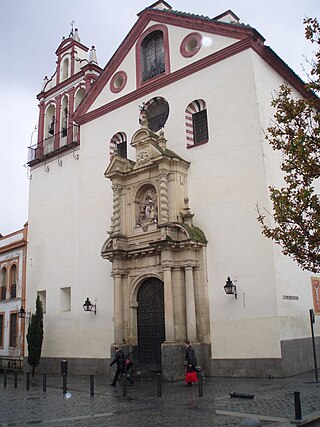
San Juan y Todos los Santos, also known as Iglesia de la Trinidad, is a Catholic church located on the Plaza de la Trinidad in Córdoba, Spain. It stands on the site of the former Convento de la Trinidad established shortly after Fernando III conquered the city in 1236. Built in the Baroque style, it forms part of the Historic centre of Córdoba, a UNESCO World Heritage site.

